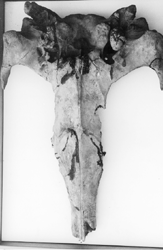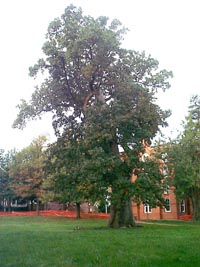
Dock of the Bay

Volume VII Number 43
October 28-November 3, 1999
Whale of a Tale: Luther Lohr Finds 70-lb. Fossil
This fossilized skull, weighing 70 pounds
and measuring two feet by three feet, required two people to dig it free
from a St. Mary's beach.
A black, pitted lump about the size of a grapefruit jutted out of the surf on a Bay beach in St. Mary's County. It was the only clue that a paleontological treasure rested just under the shell-studded gray mud.
Luther Lohr was strolling along that shore on a fine day last spring, enjoying the backdrop of the Chesapeake Bay while seeking fossils. His sharp eye focused with interest on a unremarkable lump of rock that many would dismiss as just another piece of debris.
"I've seen enough stuff that I knew it was bone," explains Lohr, an extraordinarily successful fossil hunter who lives in St. Mary's County. "So I started working to clear some stuff away."
He dug and dug until he realized this fossil was too large to remove single-handedly. He returned the next day with a hoe, a shovel and a friend to help him carry his find up from the beach.
"I did the digging. I was working with waves of the Bay coming in on me," Lohr recalls. "I was mud and dirt from head to foot. It was a mess trying to get the thing out." At first Lohr was so wet and muddy and tired from his efforts to unearth the 70 pound, two-by-three-feet fossil from the surf that he didn't stop to reflect on the value of his fortunate find. Still, he suspected the skull "was something pretty special," likely a whale.
Dry at home, he asked his friend Elinor Cofer, a local environmental activist and knowledgeable fossil collector, to come over and take a look.
"It was incredible," says Cofer. "We've never had anything found like that in St. Mary's County." Cofer passed on the news to Steve Godfrey, curator of paleontology at Calvert Marine Museum.
"This is a good piece. It's a lovely specimen of a whale skull and very uncommon in this area. This is a very important find scientifically," says Godfrey.
The skull's braincase, ear region and roof of the mouth are well preserved. Missing are the top of the skull, the area over the eyes and the side of the snout. The whole skull is a deep charcoal color, stained by the minerals that filled in the little cavities of the original bone.
The skull now resides at Calvert Marine Museum, donated by Lohr when he was assured it would become part of a permanent display of fossil whales. Lohr, a collector for about 10 years, has loaned several of his finds to the Smithsonian Institution for scientific study, but he has not given any to that museum because they would have been locked away in a storage room where the public could not enjoy them.
Lohr, a technology education teacher at Spring Ridge Middle School in St. Mary's County and part-time custom carpenter, got hooked on fossil hunting after finding a few on the beach. Paleontologist Godfrey hesitates to call Lohr an "amateur" fossil hunter because that implies that he doesn't know what he's doing. Godfrey says Lohr is "very skilled. He definitely has a very good eye for fossils."
That good eye has found about a thousand fossils over the years. Lohr's favorites are two five-and-one-half inch shark's teeth. "When I found the first one I figured that's it. That's a once-in-a-lifetime experience," says Lohr. Then a year later he found another one just 50 feet from where the first one had lain. This year, Tropical Storm Floyd presented him with a four-and-one-half-inch great white shark's tooth.
Luck certainly plays a part in finding fossils. In fact, Lohr reports, just two weeks after he found the whale skull, a storm covered the whole area with a foot of sandy gravel. If Lohr hadn't walked the beach that fine day in May, the skull may well have remained hidden in the earth.
So far Godfrey has determined that the skull dates from the Miocene epoch and is probably about nine million years old. The creature was a toothless baleen whale, not unlike today's fin or sei whales, that took huge volumes of water into its mouth and then forced the water back out through its sieve-like baleen plates, leaving the shrimp and krill in its mouth. This whale was probably a full grown adult about 20 feet long.
When this ancient baleen whale roamed the ocean, there was no Chesapeake Bay as we know it today. At that time, explains Godfrey, a shallow, lagoon-like ocean covered this part of Maryland and extended up to what we now know as Washington, D.C. The climate was slightly warmer then, similar to the Carolinas and Georgia today. Swimming along with this creature were sharks, fish, dolphins, sea cows, sturgeon, a great variety of shellfish, worms, crabs - not so much different than today. Likewise, the land looked very similar to what you find today a little farther south.
The Miocene whales exhibit will include the skull donated by Lohr plus another much larger fossilized whale skull found in Calvert County. Text panels will explain the exhibit. Godfrey may also include some intact modern whale skulls for comparison.
The permanent exhibit is scheduled to open late this year, but there's no reason to wait until then to visit Calvert Marine Museum. Volunteers are preparing Lohr's whale skull right now, removing accumulated sediment with special tools in the prep lab. Visitors can watch them at work through the large windows. Plus there are plenty of other fossils to admire in the museum's paleontology section.
-Kim Cammarata
Bits & Pieces: Beware of Deer Crossing
Maryland's white-tailed deer are on the move, energized by rutting season. That means drivers should keep an eye out, especially during early morning and evening hours when romancing and feeding are heaviest.
"The deer are just running and the road's in their path," says Maryland Deer Hunting Guide author Bill Burton. "They don't walk the roads, they just cross them."
Every year at this time, Sisk Auto Body in Owings repairs dozens of vehicles wrecked in deer collisions. "We've had three or four already since the first of October," reports Terri Sisk. "It's terrible this time of year."
With collisions come injuries and sometimes death, not only to deer but also to motorists.
Burton says fleet-footed deer appear without much warning so motorists should be vigilant and not go too fast, especially near fields, woods and marshes and deer crossing signs. No kidding: The State Highway Administration mounts the signs in spots where they've determined deer traffic is the heaviest.
-Darcey Dodd
Liberty Lost: Farewell to an Old Tree
There were heavy hearts and regrets, parting words and poignant memories, bringing to mind an old Willie Nelson song, "It was just like a funeral, but nobody died "
Nobody but a tree.
This tulip poplar had stood its ground on the campus of St. John's College in Annapolis for more than 400 years. Under it, the Sons of Liberty gathered a little more than two hundred years ago to begin the American Revolution.
Only four months ago, cuttings were taken for cloning, so the tree could be preserved in each of the 13 original colonies.
But in September, Hurricane Floyd dealt the towering, 100-foot tulip poplar a fatal blow, and October 25 the shattered tree came down, felled by arborists calling themselves Care of Trees.
At Monday's ceremony to eulogize the loss of the historic tree called Liberty, college president Chris Nelson acknowledged the tree had been "on life support for the last century."
Hundreds came to pay their last respects at a ceremony that seemed part state funeral, part community gathering. Sipping coffee and cider and nibbling pastries, mourners listened to formal words of comfort, their backs turned away from the huge tree now roped off by bright orange fencing.
Nelson said good-bye to the "venerable old tree this symbol of freedom and liberty." Gov. Parris Glendening gave his "farewell to a very old friend," reminding listeners that "with this tree the seeds of revolution and freedom were started here."
Annapolis Mayor Dean Johnson called Liberty "the Cal Ripkin of trees. "When it was young, freedom was a fantasy."
As the respectful crowd bowed their heads during the moment of silence, from the tower of McDowell Hall bells tolled 13 times.
Comment books gave place for all who came to express their thoughts. "Farewell, Liberty Tree!" wrote John Potter, "thanks for supervising our waltzes and our croquet victories over Navy."
"In the fourth grade, it took my entire class to span the trunk of this tree," Melanie Ann Jewett wrote.
Ann McGinnis Hillyer noted: "A great day to celebrate our history. Let the progeny flourish."
A few hundred feet away, progeny did flourish. Son of Liberty, planted as a seedling in 1889, was dedicated as the new "Liberty" even as old Liberty's long life on this good earth was about to end. One of old Liberty's clones will be planted on the grounds of the Maryland State House.
-M.L.Faunce
News of the Weird: Still Crazy After All These Years
Two green-faced aliens were seen reading "Chuck
Shepherd's News of the Weird" in a downtown Toledo coffee shop right
before pulling ray guns and demanding double lattes to go, to be made only
from coffee beans pre-digested by Asian animals.
Okay. That story isn't completely true, but everything is real in "Chuck Shepherd's News of the Weird." This year, Universal Press Syndicate marks its 10th anniversary of syndicating this popular feature, which provides readers of about 300 newspapers with a hilarious, irreverent look at today's news. (Actually, there are pre-digested coffee beans on the market; "News of the Weird" reported that back in 1993.)
The feature originated as a hobby in the 1970s when creator Chuck Shepherd was working as a lawyer and began collecting bizarre news as a form of amusement and "mental health relief." The hobby evolved into something more in 1981 when Shepherd gathered all the yellowing clippings he'd been saving and published the stories in a newsletter that he sent to friends.
Washington D.C.'s City Paper began running the material as a column in 1988, and Universal Press started syndicating the column a year later. Originally a staple of weekly alternative publications, "News of the Weird" now appears regularly in both mainstream and alternative newspapers, including New Bay Times~Weekly, in the U.S. and abroad.
Among the things "News of the Weird" anthropologically tracks are ridiculous lawsuits, incompetent criminals and questionable medical breakthroughs - with only the criterion that the story was reported in the daily papers (but not too widely reported). Readers also find all the latest trendy excuses bad people give when they get caught and the astonishing number of murderers with the middle name of "Wayne."
"I'm like a trafficker," says Shepherd, "a pusher, for the people who need to know this stuff so they can feel normal. They say, 'Oh, I'm a little weird myself sometimes, but at least I'd never set up a Shrine of the Weeping Shirley MacLaine,' as a Hollywood rabbi did two years ago. Or 'kill my best friend over a Monopoly game because we both wanted to be the car,' which happened in New Jersey in 1992."
Shepherd believes it is his selectivity and sardonic writing style that distinguish "News of the Weird" from other sources of bizarre news. "You don't need to scream these stories out," says Shepherd. "Readers know civilization is in decline all around them. They're just looking for a little reassurance that it's other people who are the problem."
Collections of "News of the Weird" fill five paperback books. The latest is "The Concrete Enema and Other News of the Weird Classics" (1996). This year, the feature was taken to a new dimension when Universal Press Syndicate's interactive division, Universal New Media, launched the interactive show "Xippy Malone, Cub Reporter" on Universal's uexpress.com Web site. Xippy, the first interactive news reporter on the Internet, takes viewers on a playful tour of "News of the Weird" stories.
Shepherd now lives in Florida, which he says gives him an "incredible vantage point" for his work. According to Shepherd, there was a guy on the east coast of Florida a few years ago who ran sort of a "Foot of the Month Club" for fetishists. "He advertised 'Molded rubber models of women's feet. $29.95 a foot. Different woman each month.'" Gushes Shepherd, "I'm in Weird Central."
Universal Press Syndicate, headquartered in Kansas City, Missouri, is the world's largest independent newspaper syndication company.
-Laura O'Brien
In New Zealand, this shark attack was a marine version of "man bites dog." Bev Marshall-Smith beat a six-foot-long blue shark to death with a piece of driftwood when it followed her lure into shore. She grabbed it by the tail, and "every time he wrestled, I hit him," she said
In Illinois, 20,000 red-winged blackbirds were found dead last week near St. Louis after feeding on grain that had been poisoned with the deadly insecticide Furadan, the St. Louis Post-Dispatch reported. Since they are a federally protected migratory species, a farmer has some explaining to do
In New Mexico, it was a different kind of diaper duty at the Navajo Dam last week. A clean-up crew used throwaway diapers to soak up a 50-gallon spill of hydraulic fluid, thereby preventing much of it from flowing into the San Juan River ...
In China, the Wild Yak Brigade no longer exists. The Chinese government disbanded the group of wildlife guardians that tries to protect the chiru, a Tibetan goat whose fine wool is greatly prized, the Wall Street Journal reports. Poachers kill about 20,000 of them yearly, but Red China is apparently worried about green movements ...
Our Creature Feature comes to us from Minnesota, where Mary Lou Ayers believes she has a turkey of an insurance policy.
Ayers, of St. Croix, is upset that her company won't cover the costs she incurred when a wild turkey smashed through her window and bloodied up her home while flopping about.
"I think everyone should look into their policies," she told the St. Paul Pioneer-Press. On the other hand, Mary Lou may be readier for Thanksgiving than most of us.
| Issue 43 |
Volume VII Number 43
October 28-November 3, 1999
New Bay Times
| Homepage |
| Back to Archives